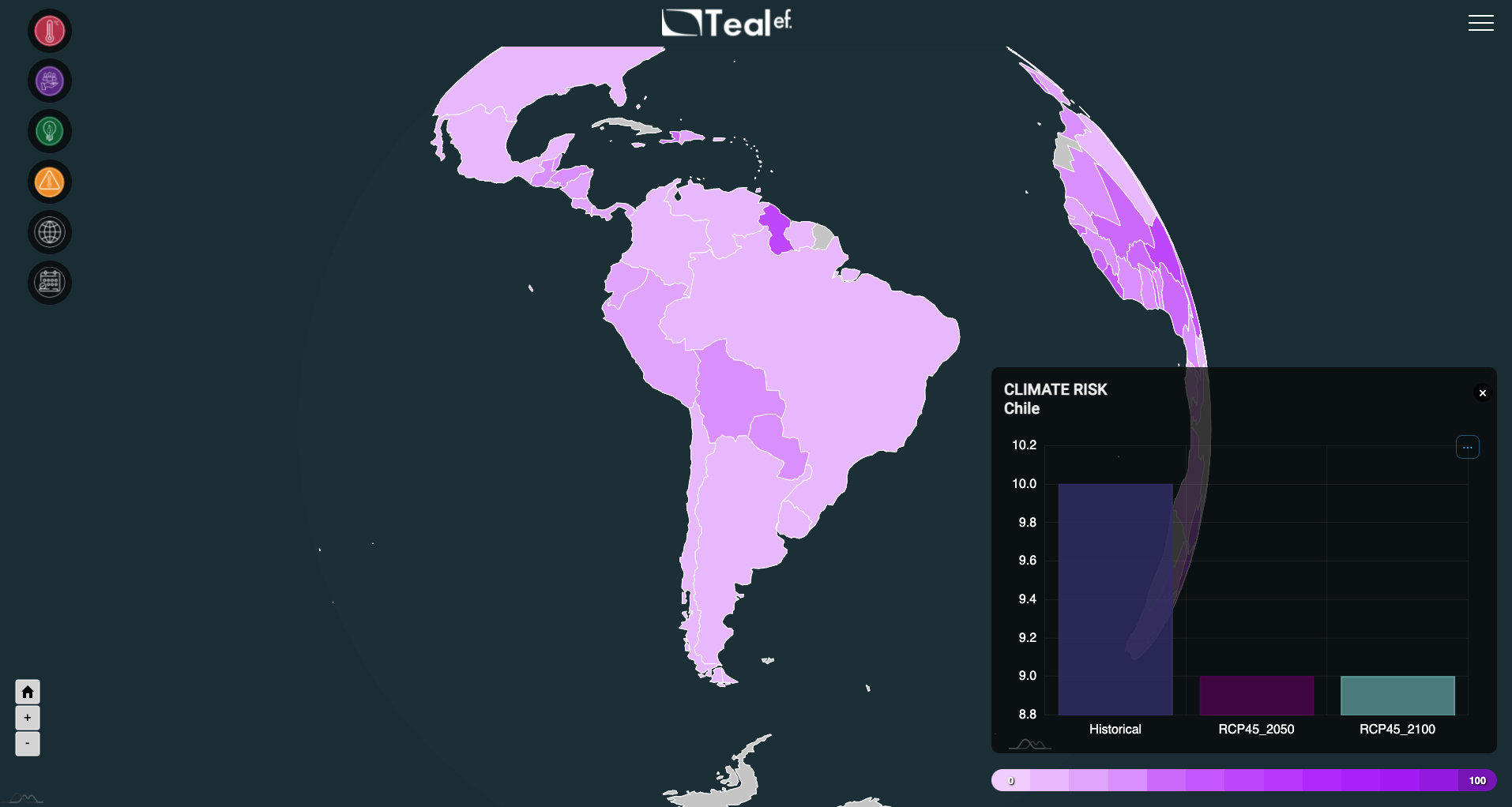Teal EF: Explore climate data and other societal indicators easily
WHAT IS TEAL EF?
Teal EF is a free visual tool, developed in collaboration with ENEL Foundation, that enables you to explore climate variables together with innovative composite indicators that allow to evaluate the effects of climate change, the opportunities deriving from the energy transition and to evaluate specific dimensions of wellbeing.
WHY CHOOSE TEAL EF?
Teal EF provides free access to easy-to-use climate data and several new indicators at country level within three domains: Wellbeing, Climate Risk and Energy Transition. In the Wellbeing domain you can access composite indicators for Demography, Equality, Health, Education and Labour. In the Climate Risk domain you can find historical and future dimensions related to Temperature, Hydrogeological and Wind hazards. In the Energy Transition domain you can access composite indicators for Emissions, Fossil Fuels, Renewables, Efficiency, Electrification.
TEAL EF BENEFITS

Evaluate specific dimensions of wellbeing

Evaluate the opportunities deriving from the energy transition

Evaluate Some of the risks due to climate change
Teal EF Background
Teal EF builds on the public version of Teal (tealtool.earth) and is developed jointly by WEMC and ENEL Foundation.

Teal EF is a free visual tool that enables you to explore climate variables, carbon emissions and other indicators and features which are being actively developed and added. Documentation, guidance, functionality and data are periodically generated and reviewed for inclusion. The developers are not liable for consequences due to decisions taken on the basis of the data displayed in and provided through the tool.
An Enhancement of Country Indicators
Country risk indices usually take into account only macroeconomic dimensions and traditional performance indicators.
On the basis of the redesign options of the macroeconomic and business impact analyses, we put forward innovative composite indicators that allow to evaluate the effects of climate change, the opportunities deriving from the energy transition and to evaluate specific dimensions of well-being not traditionally taken into account in the assessment of country risks.
Wellbeing – starting with demographic and inequality composite measurements as base line and health, education and jobs as essential instruments to ensure well-being over time.
Climate Risk (The New Normal) – recognising that we are into a new normal where major meteorological events are indeed extreme but no longer exceptional.
The Energy Transition – considering that only actively pursuing the energy transition under any possible dimension – from policy to regulation, from health to education – will enable countries to benefit most from the opportunity to build back stronger after the COVID Crisis.
Teal EF – Documentation
Variable Fact Sheets
Click on an icon below to download a factsheet for that variable, containing definitions, fun facts, a glossary and more!
Climate Variables
The following climate variables can be selected via the Edu Demo: air temperature, wind speed (at 10m height), total precipitation and solar radiation. These are chosen both for their importance as climatic indicators, but also because the are the main factors affecting the energy variables displayed with the Edu Demo.
Air temperature is the main indicator of how the climate evolves. It is linked to electricity demand, and can also affect solar power production.
Wind speed provides an indication of the strength of the atmospheric circulation. It is also linked to wind power production.
Precipitation provides an indication of how wet or dry the earth system is. It is also linked to hydroelectric production (the latter is not currently available on the Edu Demo).
Solar radiation is the amount of energy coming from the sun that reaches the ground. It is also linked to solar power production.

Carbon dioxide (CO2) is a colourless, odourless and non-poisonous gas formed by combustion of carbon and in the respiration of living organisms and is considered a greenhouse gas. Emissions means the release of greenhouse gases and/or their precursors into the atmosphere over a specified area and period of time.
Info on the datasets/CSV files
Current version: v1 (25/05/2021)
What’s New:
- Update: New variables: Wellbeing, Climate Risk, Energy Transition
- Update: Improved load times
- Update: Custom URL ef.tealtool.earth
- Update: Updated about info
- Update: New webpages and resources
Known Bugs:
- Sub-Countries view takes time to load
Contact:
Please contact us for more information and opportunities surrounding Teal EF. If you encounter any issues using the tool, these can often be resolved by deleting the cookies on your browser and refreshing the webpage.
If you discover a persistent and repeatable bug, please send us a message, including your browser (eg Chrome, Firefox etc) , operating system (OSX, Windows, Linux) and device (PC, iPhone, tablet).












